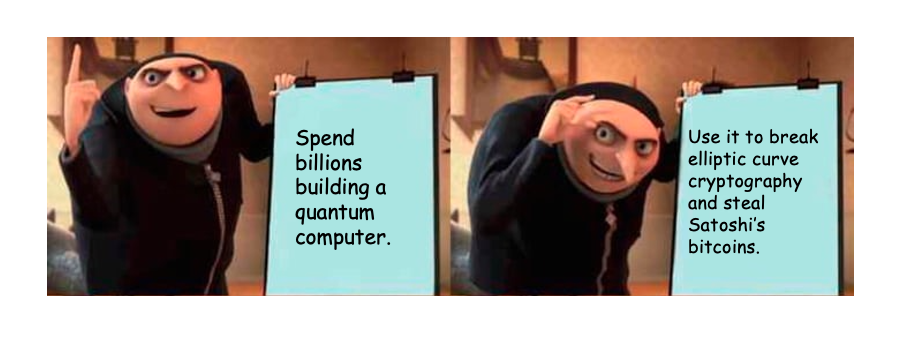Over a dinner recently, a friend introduced me to a new financial argument for building error-corrected quantum computers. This argument, so potent in its persuasiveness, justifies spending tens or even hundreds of billions on quantum research.
Here is the argument:
- There is a stash of roughy a million bitcoins owned by the wallet of Satoshi Nakamoto. That’s roughly 100 billion dollars at today’s valuation.
- A wallet is basically two numbers: there is a public key which, like an email address, is publicly known and people send their money to this address and this number gets recorded in ledgers. And there is the private key which is basicallly a password and lets you spend your money by sending it to other wallets.
- If you had access to Satoshi’s private keys, you can spend all the money in that wallet. But, of course, no one but Satoshi has the private keys.
- But the public keys are known and written all over the bitcoin ledgers, and everybody knows what they are.
This is where the quantum computer comes in.
- You build a quantum computer that can break the elliptic curve cryptography that bitcoin uses. You can do this because we know Shor’s algorithm can solve the underlying math problem.
- Use this quantum computer to learn the private keys of Satoshi’s wallets.
- Spend all that money. A hundred billion.

Now, this is a good argument whether you like or dislike bitcoins.
If you like bitcoins, you now own a lot of it. You can keep holding it or you can spend however you want. If you don’t like bitcoins, you can tank the market by giving it away for free.
This argument also means that the investment in the quantum industry is a pittance compared to the rewards you may reap some day.
But, none of this would work if one of the following things happen:
- Satoshi reads this blog post and cashes out, or decides to move all his coins to another blockchain that doesn’t use elliptic curves.
- Somehow BTC goes below the argument’s breakeven point. This may happen if people read this post and think “Well, I cannot hold all this money knowing that someone might just steal it one day with a better computer. I thought bitcoin was forever! I have been lied to!!”
- Nations and powerful people decide that quantum computers now threaten global economic systems and they prevent any further work on quantum computers (in the style of Three-Body Problem)
Error correction is very, very far. But, a lot of the things I thought were very very far in 2018 came true in a couple of years. If you believe, like many do these days, that the line of technological progress always goes up (a belief that is increasingly justified) and that everything not expressly forbidden by physical/computational laws will indeed happen, it is only a matter of time before the plan outlined above may come true.
The question everyone has is about the timing. When will it all happen?
That, I don’t know. I will tell you with a hundred percent certainty it won’t be the next few years. We have shown error correction sort of works. Google’s paper on the Willow chip describes how they developed one still-very-noisy fault-resistant qubit. To run an algorithm like Shor’s, they need to do orders of magnitude better in terms of noise suppression. That will still give a single logical qubit; hey will have to replicate the single logical qubit thousands of times, and allow gates and operations between them. It is a task easier said than done.